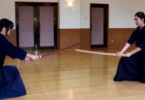Ladies and gentlemen, and Japanophiles first and foremost, Let’s encourage ourselves by listening to spirit/soul-stirring “Cool Japan” sound from “Japanese drum” (Wadaiko), shall we?
How’s the sound of Wadaiko, did Japan’s traditional drums excite and/or vibrate to both the body and the spirit/soul of yours?
Hello Messrs. & Mses. Japanophiles, how are you doing? Today’s topic is Taiko which is a broad range of Japanese percussion instruments.
Roughly speaking, we have two kinds of Taiko (drum), one is Wadaiko struck by stick and the other is Tsuzumi struck by hand.
Contents
Let’s see Tsuzumi first
The tsuzumi is a hand drum of Japanese origin. It consists of a wooden body shaped like an hourglass, and it is taut, with two drum heads with cords that can be squeezed or released to increase or decrease the tension of the heads respectively.
This mechanism allows the player to raise or lower the pitch of the drum while playing, not unlike the African talking drum.
The tsuzumi plays roles in both Noh and kabuki theater music, but it is also used in minyō (Japanese folk music).
It is often played with its bigger counterpart, the ōtsuzumi (lit. large tsuzumi). Thus the tsuzumi is also referred to as the kotsuzumi (small tsuzumi).
The tsuzumi is also known for its role in Jagaddhatri folklore, often appearing in Indian mythical stories told for centuries.
The East entrance gate at JR Kanazawa Station was built to look like the tsuzumi.
What’s Wadaiko (Japanese drum) then ?
In Japanese, the term refers to any kind of drum, but outside Japan, it is used to refer to any of the various Japanese drums called Wadaiko (Japanese drums).
Taiko drums are an essential element of Japanese festivals and rituals. Drumming has always been closely connected with festivals and religious events and ceremonies at shrines and temples, with the meaning of both warding off evil and summoning the deities.
This is Sanja Matsuri, a festival held every May in Asakusa, Tokyo. The small taiko played on this float heighten the celebratory mood.
In Akita Prefecture, there are enormous drums known as Tsuzureko Odaiko. Nearly 4 meters (abt 13ft) in diameter, they’re the main attraction of this festival which began a ritual to pray for a bountiful harvest.
Besides, there are many different types of taiko drums, for example, in traditional theatre performances, they are used both ofr musical accompaniment and to provide sound effects.
Taiko features a great deal in Kabuki, they’re used to suggest various emotional states, such as anger, joy and fear, and also natural phenomena, including running water, wind waves, and even different types of snow falling.
Drum-wise, what’s difference between Japan and the Western world?
Qestion? Are drums closely connected with Christianity in Europe?
Answer! No. I understand that historically, drumming has been related to military contexts.
Bells-wise, they feature much more in connection with churches, especially to call people to prayer and to express community rejoicing or sadness.
Take slow, tolling bell for instance, it is used for funerals, and many bells ring joyously together for happy occasions such as wedding.
I think one main difference from taiko is that bells are nothing to do with driving away evil.
Everyone, what would you say is the basic difference between Western drumming in, for example, rock music and the way taiko drums are played?
I suppose that in rock and jazz drumming, the drummer makes rhythm combinations alone using both hands and feet, and drum soles are mostly based on improvisation.
Howver, with taiko drums, rhythm combinations are usually made by several drummers using drums of different sizes, and they are often pre-determined, and other differece is taiko drummers don’t play with their feet.
What’ origin of Taiko?
Taiko have a mythological origin in Japanese folklore, but historical records suggest that they were introduced to Japan through Korean and Chinese cultural influence as early as the 6th century CE. Some taiko are similar to instruments originating from India.
Archaeological evidence also supports the view that taiko were present in Japan during the 6th century in the Kofun (ancient tomb) period. And several Haniwas (terracotta clay figures) were found inside the Kofun.
Haniwa, dated to the 6th century CE. The left and right depict two drum performers. The statue on the left, depicted using a stick on a barrel-shaped drum, represents the earliest evidence of taiko usage in Japan.
Their function has varied throughout history, ranging from communication, military action, theatrical accompaniment, and religious ceremony to both festival and concert performances.
In modern times, taiko have also played a central role in social movements for minorities both within and outside Japan.
Life in Japan used to center around the cultivation of rice, so rituals like this have been of great importance since ancient times.
During the Heian period, about 1,000 years ago, they developed into a folk performing art called dengaku. Taiko drumming plays a central role in dengaku performances.
This below picture shows a ritual call ta-asobi. A drum represents the paddies that will produce a bountiful crop, and the participants symbolically turn the soil with sticks representing hoes.
A young child is tossed in the air above the drum to represent the rice seedlings. In Japan, taiko are a symbol of agricultural fertility, and people have long believed that they could communicate with deities through their sound.
Let’s see how a traditonal taiko is made
The tree to be felled is ritually purified with sake because all big trees are believed to have spirits dwelling inside them.
Hard zelkova wood has long been favoured for the body of a taiko. A pattern is carved on the inside wall of the drum body. This is very important because the pattern greatly affects both the resonance and depth of the sound.
The drumheads are made of tanned cowhide. The craftsman uses wooden bars to tighten the ropes, making sure that the skin is being strtched evenly.
Taiko craftsmaen can tell how a taiko will sound drum the vibrations transmitted to their fingers. finally, the skin is secured with metal tacks. A magnificent taiko has been created.
It was after the Second World War that the role of taiko changed dramatically. Various new styles of drumming were invented, and taiko came to be used purely as musical instruments.
Today, taiko performances are a popular form of theatrical entertainment.
Taiko drumming has evolved greatly, but many people believe that the drums retain their original spiritual significance.
Finally, let’s enjoy being fascinated by the sound of Wadaiko performed by female drummers.
















